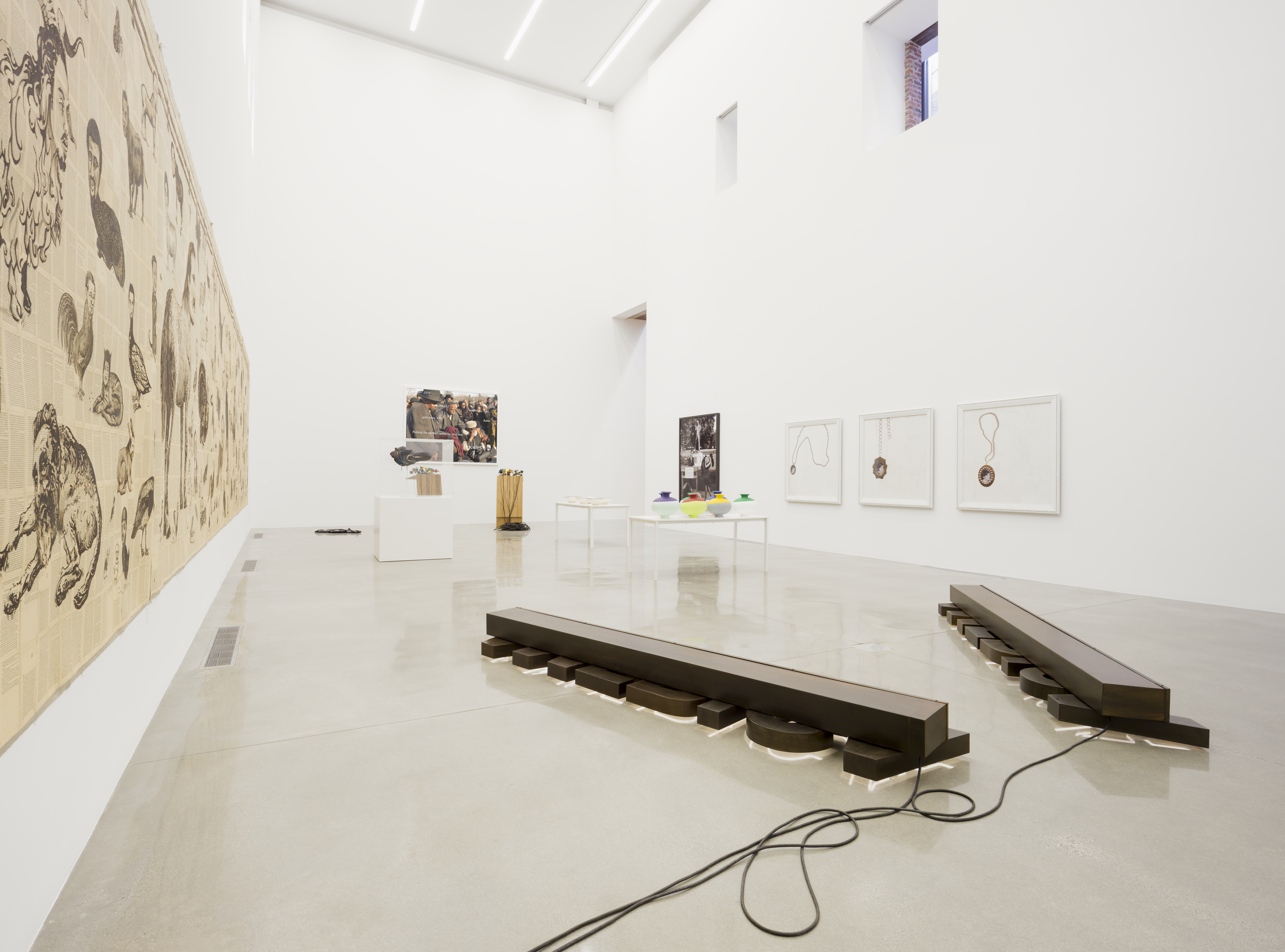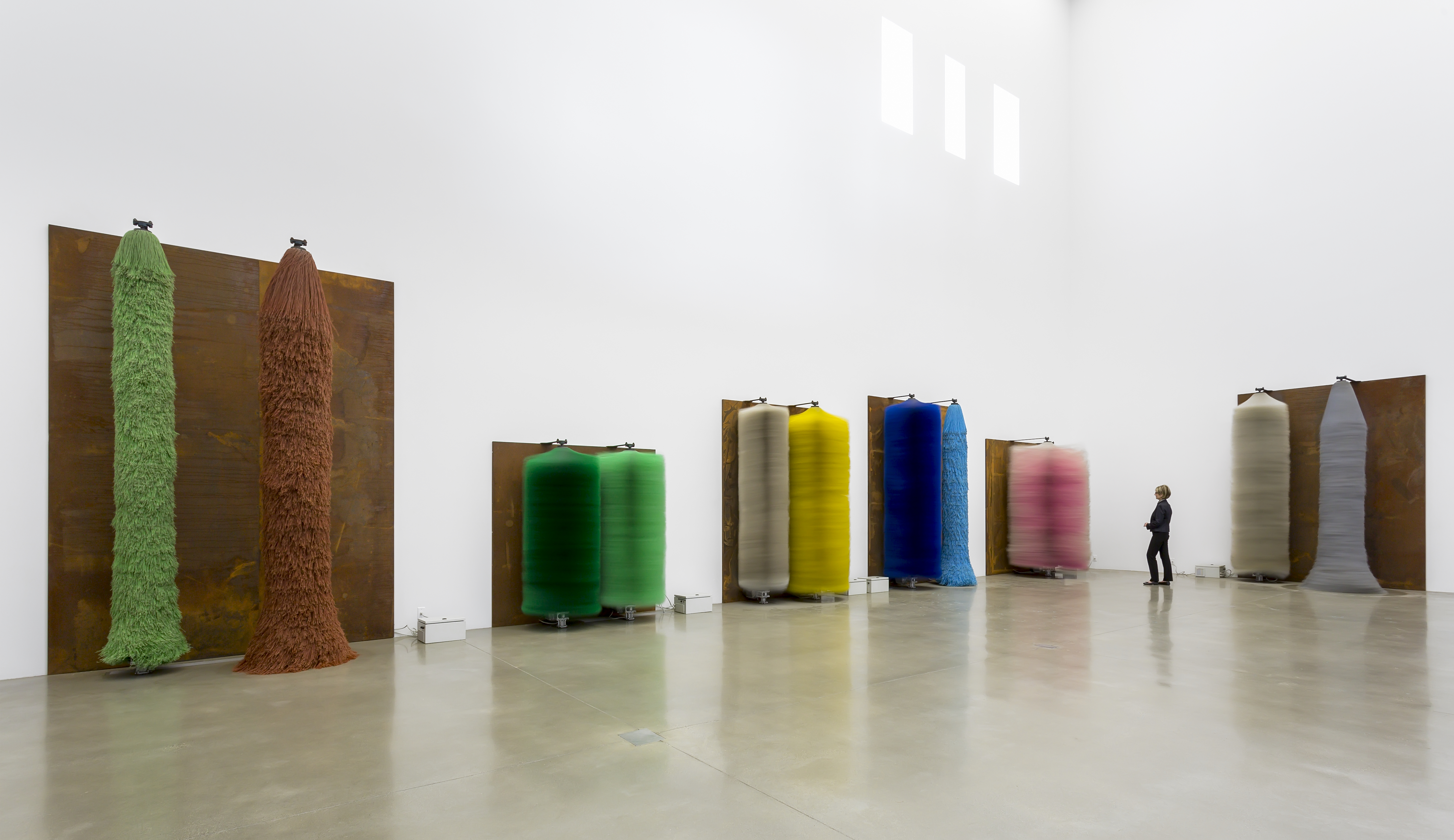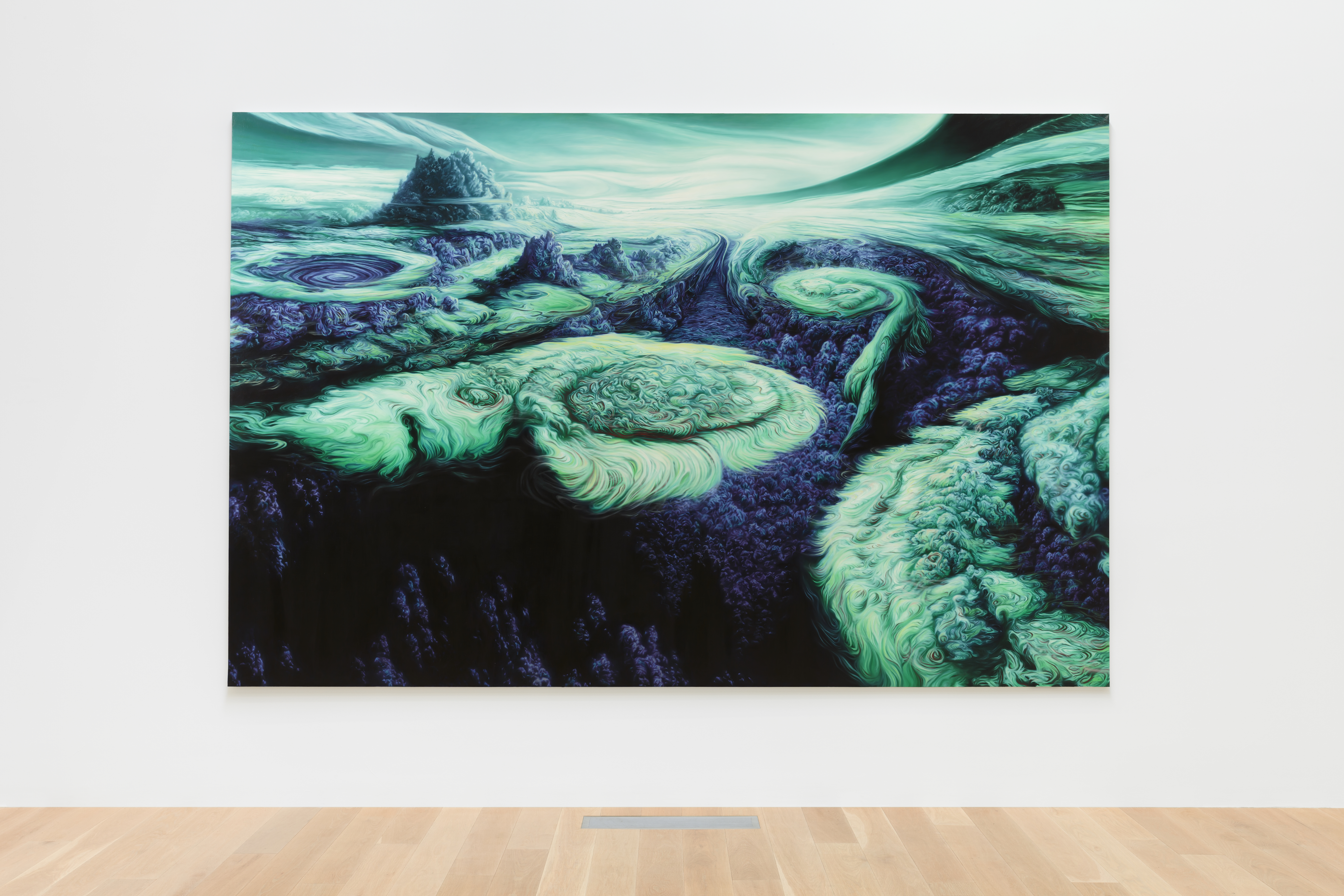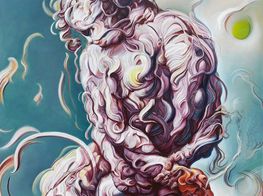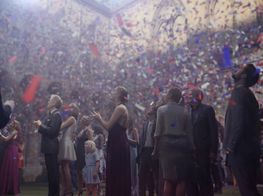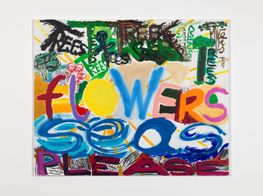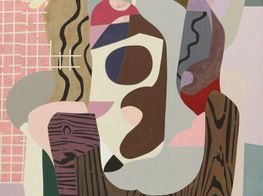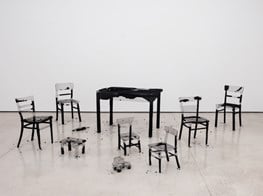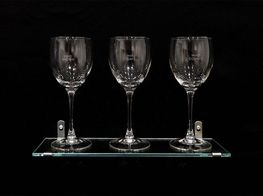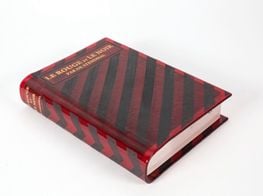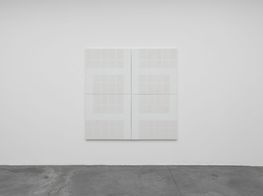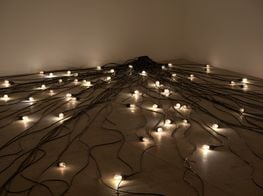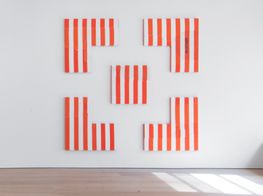Bob Rennie
Image: Bob Rennie in front of Martin Creed's neon Work No. 851: EVERYTHING IS GOING TO BE ALRIGHT, 2008. Courtesy the Rennie Collection.
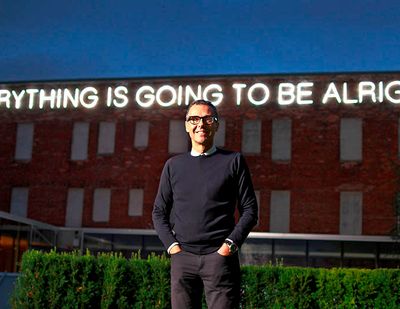
Image: Bob Rennie in front of Martin Creed's neon Work No. 851: EVERYTHING IS GOING TO BE ALRIGHT, 2008. Courtesy the Rennie Collection.
In Vancouver's Chinatown, an area wedged between the gleaming office towers of the city's affluent West End and the city's poorest neighbourhood, Downtown Eastside, is a gallery showcasing work from one of the world's leading private collections.
Housed in a restored iteration of Chinatown's oldest building, the Rennie Collection at Wing Sang also represents one of the largest collections of contemporary art in Canada.
Its owner, Vancouver-born, self-made real estate marketer, Bob Rennie started collecting art as a teen. The collection now includes more than 1,500 works by more than 350 artists, and exhibitions are held twice-annually and are free to the public.
The gallery in Chinatown was constructed in 2009 as a way to share this immense collection and also Rennie's passion with the public. From its rooftop, a Martin Creed neon installation beams the promise 'Everything Will Be Alright' to the streets below, where wealth disparity and social and racial inequalities are tense issues.
The work echoes Rennie's belief in the redemptive power of art and also reflects his interest in collecting work that addresses issues of identity, injustice, prejudice and race.
ADAs a way to begin to understand the Rennie Collection, can you discuss a recent acquisition?
BRThe most recent acquisition is Yoko Ono's Mend Piece (1966/2015). Mend Piece is comprised of chairs and a table which has upon it a number of broken cups and saucers, where visitors to the museum will be able to sit and glue or tape to mend the cups. It's the sixteenth time that Yoko has installed this work. I feel it's an important work. The first time Yoko installed it was in '66, and she met Lennon that year, at her show. To the best of my knowledge, this is the first time the work has been acquired by a collection.
The mother of my children is Japanese and she used to tell me that when a cup breaks, even though you can glue it together, the cracks always show. I used to joke that if you mend it with crazy glue it might be stronger. In earlier times, when important Japanese pottery broke, it was mended using gold to heal and seal the crack. I think that Mend Piece is so important and relevant to what's going on in the world today. We didn't acquire the work soon enough to install it for the current show, which relates to the idea of 'chaos' and involves works by 41 artists from the collection; it would have fit into the show so perfectly. We will install this probably in 2018.
ADWell perhaps it can be used in a follow-up show?
BRWe could do six shows on the idea of chaos, each using different works from the collection. But this show is really tight and a bit disturbing, so we're really happy with it.
ADDo you think that the fact you have so many works that might fit into a show about 'chaos' reflects how the collection is being put together, or does it reflect the state of the world?
BRWhat really interests me about the collection is how it will be viewed 25 years from now. What will it say about what was important on the planet (and what wasn't important)? What problems did we solve, and what were we preoccupied with?
In this show, which is focused on this idea of 'chaos', I installed Tim Rollins and K.O.S.' enormous painting_Animal Farm_. The work is from 1992, and it depicts the politicians and prominent voices that were on the planet then: Brian Mulroney, a former Canadian prime minister, is seen as a dog, George H. W. Bush is seen as a fox, and Nelson Mandela is a raven. If this work is reimagined today, it would probably feature Donald Trump and you would have Merkel, but you can't see the forest for the trees. You have to get away from it to understand the impact they impart on history.
A large part of the collection has always addressed social injustice, identity, social commentary, and race. This was a chance, given what's going on in America (even though we live in Canada) to really pull out some works that point out how upside-down America is right now, including Glenn Ligon's piece that he did last year—it's 10 to 12 feet wide and it features two neon signs that spell out 'America', but they lie face-down on the floor randomly flashing like they're burnt out.
ADWhat was the starting point for the show?
BRThe first piece I ever acquired is a Norman Rockwell painting which depicts a boy and girl sitting on top of the world. I was 17. I came from humble beginnings and from a poor family. The work was US $375 and I bought it on a road trip from San Francisco. My family didn't have a bank account, and I had to pay US $64 to ship it. We had to borrow the money from neighbours.
We also wanted the show to convey a feeling of chaos by virtue of the way it is presented—by presenting too many topics for the senses. I wanted people to feel overwhelmed by at least one or two of the works. Not everybody is going to react to the same works of course, but we are receiving good reactions to the show—I'm really happy. We don't usually cluster so many artists together. We usually do solo shows. This was a real breakthrough for us.
Back then, I believed that the utopian world of the boy and girl sitting on top of the world was out there, that it existed. The works in the collection and in the Chaos show reflect the actual reality of the world, one that's reflected in works by artists such as Christian Boltanski's Holocaust-related work, Mircea Cantor's puzzle map of Israel, Andres Serrano's piece from his Morgue series and Gilbert & George's 48' Bomb work from 2006. I just felt that given what's going on right now, we needed to do a show like this.
ADDo you have any expectations or hopes in terms of how an audience might engage with this work? Any hopes for what they might take away from it?
BRWe're quite informal. There's no curatorial essay and we never even title shows. 'Chaos' is only our conceptual title. The idea of chaos was within my head and it became the idea for this show.
Our museum is open three days a week to the public, and we hire BFA and MFA students from local universities as interns who walk groups of visitors through the shows. There are 15-20 people in each group that goes through the museum, and the interns explain each work.
Our expectation with guided tours is that you may not like what you see, but at least you'll know why you didn't like it. Whether the audience is relating the work to art history or relating it to current times, I prefer that they are informed.
We also wanted the show to convey a feeling of chaos by virtue of the way it is presented—by presenting too many topics for the senses. I wanted people to feel overwhelmed by at least one or two of the works. Not everybody is going to react to the same works of course, but we are receiving good reactions to the show—I'm really happy. We don't usually cluster so many artists together. We usually do solo shows. This was a real breakthrough for us.
ADYou present a lot of solo shows. The last solo show presented by the collection was dedicated to Italian artist Lara Favaretto. Why did you decide it important to dedicate one of your exhibitions to her?
BRWe've been collecting Lara for a number of years, so I consider what we've collected to reflect real depth. We're never interested in acquiring a moment. We collect works that span a career; with Lara from early works to a more recent installation comprising seven sets of full-size carwash brushes [Coppie Semplici/Simple Couples (2009)].
Lara's work has been in storage for so long and I wanted to share it. I felt that her confetti room [tutti giu per terra/We all fall down (2004)], for example, should breathe and be seen. It is the best landscape 'painting' we own.
ADI was interested to see that the image on the collection's website that is used to promote the current exhibition is Priceless (2004) by Hank Willis Thomas. Why that particular image?
BRI bought it in 2004 and it really was one of those works that I thought, 'I want to see how this reads in 20 to 25 years'.
ADIt looks so now, doesn't it?
BRAbsolutely. With what happened in Ferguson ... I hung it in my office, with Glenn Ligon's Warm Broad Glow (Dark), a darkened neon that spells out the words 'negro sunshine', and three large ink drawings by Kerry James Marshall. I share my office with my son. Priceless was a tough work to bring in. Lying behind this work is a funeral, and the image in The New York Times [of Michael Brown's funeral] almost duplicates that Hank Willis Thomas image.
The work bothers people; the humour of Priceless bothers people. And there's that deep-rooted fear of choosing a casket for your child that just takes people's breath away.
Having regard to 'chaos' as a concept for our current show, the other image we put up on this site is Tavares Strachan's neon work,I Belong Here (Exploded) (2011).
I often talk with a collector friend of mine, Pamela Joyner, who sits on a Tate board with me. A piece from 1990 by Gary Simmons which says 'wrong n-i-g-g-a to fuck with' was added to our collection. Pamela wanted it. Pamela is African-American. She and I talked about that work and she felt that it's probably because I didn't grow up in America, that I can own and show that work and not be compensating for, defending, or highlighting any position. It's a safe place from which to show Gary's work in conversation with work by Palestinian artists, British artists, Colombian artists.
And with the Hank Willis Thomas work, the same applies: I am not in Ferguson, nor Chicago, nor New York, because I am not trying to extract anything other than to present it as a way to reflect the world we live in—a world which is so upside-down right now and which I fear is getting worse.
ADIt feels that there are these enduring issues of race that you want the collection to highlight?
BRYes, it is one of the descriptives within the collection. The first work visitors see when entering the current exhibition is John Baldessari's albino camel, [Camel (Albino) Contemplating Needle (Large) (2013)]. It's a white-as-white camel which is nine feet tall and made of fibreglass. The camel is staring into a ten-foot needle. We asked John Baldessari if we could have permission to add text on the wall beside the camel. The Arabic script spells out an idiom which states that 'it is easier for a camel to go through the eye of a needle than for a rich man to enter the kingdom of God'. We wanted the entrance to the exhibition to deal with corporate culture, which is a huge factor in America's chaotic condition and social divide.
ADYou've earlier mentioned the Tate acquisitions committee. How long have you been part of that?
BRI've chaired the North American Acquisition Committee for the last six years.
ADWhat have you learnt from that role, and how do you perceive that the art world has changed via your experiences in the role?
BRMy goal is that the committee supports the curatorial direction of Senior Curator Mark Godfrey. I think as we have grown from nine or ten to 49 people on the board; you can see the extreme diversity in collectors. My goal is to make sure that I never push the philosophy of my own collection onto that group and that within the group, where I can help it, we don't collect with our ears, we collect with our eyes.
One of the things on the board that we have to be conscious of is that our budget at Tate is no different than our personal budget, so we have to think about whether we are going to collect more, or buy better. I stepped down from the board this May as Chair and I've left something I'm really proud of: we decided to put away US $250,000 a year to make a major acquisition. The first major acquisition will be a Kerry James Marshall painting. So now the board has a platform to save up for something important. Rather than trying to collect a bit of everybody, we are trying to collect significant works by a few artists.
ADCertainly something that has changed during your time on the Tate Acquisitions Committee is the rise of the private museum. I wanted to talk about the idea of a private museum, because in many ways they are operating to define the 'art of our time' to the same extent as public institutions are tasked to do. Do you see any responsibility in terms of how you operate the collection given its public nature?
BRWe do have an approach of taking on the more challenging work. We often say: 'If you can't sell it, we're probably interested in it'. We take on larger installations that should be exposed, which probably enables us to step outside of the competition with the richer guys buying for their homes. But equally, it means that we end up competing with public institutions who tend to be strapped for cash for such pieces, just like us.
But I look at [the collection], and I think, I am only the custodian of these amazing works of art and as a custodian I have a duty to show them, and to make them available to the public. So we tend to have about 15-20 works out on loan to museums to make sure that we're looking after the artists. The artists need to have their work shown.
I learnt very early on that artists are the smart ones. Never pretend to know something that you don't. That rule works in life, not just with artists.
I am meeting with Simon Starling tomorrow, and Andrew Hamilton who co-directs The Modern Institute. We will spend two days looking at our space to lay out the November show. If an artist wants to add a work in the show to tie something together, we have to acquire it. One of our boundaries is to only show collected works. We really feel that we have a responsibility to do some things that museums aren't able to do. We can make mistakes and we can be a lot more vulnerable, because we're not catering to a board: the only board we're catering to is Carey Fouks and my children, so we have a lot more flexibility.
ADBeyond your lifetime, what are your hopes for the collection?
BRI'm sixty today, June 4. If I die tomorrow, the kids can do whatever they want with the art.
They know the Kerry James Marshalls and the Glenn Browns are so close to my heart, and that I want them to stay in the family. However, they can do anything they want. But as I get to 65 and 70, there'll be much tighter restrictions on how we want the museum to continue to operate and what works we want to go to museums, and to which ones.
Then by 75, that doctrine will be frozen. But right now, to burden the kids with the cost and responsibility of running a museum: I can't. Everybody knows the collection is heartfelt and I just trust everybody that if I drop dead tomorrow, they wouldn't be irresponsible with donations and sales.
ADYou mentioned before that your family would know which works are especially important to you. Are you able to share an anecdote or story about acquiring a work that has a particular emotional importance for you?
BRThere's a work by Glenn Brown from the year 2000. It was in the Turner Prize competition. It's large—about 7 feet by 11 feet. I wanted it, but we didn't have the money. I had Andy Warhol's prints of ten [Campbells] Soup Cans from 1962 and hated that every time people came to our home—we didn't have the museum then—they were all anyone talked about! So Patrick Painter, who was representing Glenn back then, came over to me and said, 'See over there?
That's Max Hetzler.' Max was also representing Glenn and he said, 'The man sitting next to him is Jeff Koons' biggest collector. If you don't buy the Glenn Brown, he's going to buy it'. I had ten minutes to make a decision on the work, and I said, 'We'll do it.' I came home and sold the Soup Cans for US $75,000. A year and a half later, the Soup Cans sold at an auction for about US $497,000 and Glenn still wasn't worth US $100,000. Sixteen years later, I think the Soup Cans are worth US$ 1.5 million dollars and Glenn's painting is worth US$ 6-7 million.
Along the journey, you have to follow your heart. If I was only thinking with commerce in mind, there's no way that the Soup Cans should've been sold to buy Glenn Brown at the time. I actually made those decisions not based on commerce.
In terms of money, I believe that one-third of the art collection outpaces any other monetary instrument, one-third almost keeps up with the cost of inflation, and one-third is equivalent to taking a match and burning cash. But for 10 or 20 years, you won't know which of those categories a work falls into. I don't understand the commerce game where people are buying to sell. It's just not what we want the collection to be.
ADI've always found the most interesting collections to be the ones with 'mistakes' in them. Because these collections often reflect a more genuine story of engagement with art, one reflecting a real journey based on passion.
BROne of the most important features in the collection is in this show; it's a documentary photograph from the early sixties with a ten-year-old boy holding a poster that says, 'who needs niggers' (obviously his parents' views). It probably has a value of five dollars. I'm always conscious of whether it's in my house or in my son's house. It's super important to the collection, but there is no monetary value.
ADThis is another work that raises the issue of race. At what point did social injustice, particularly race, start to become so important to you?
BRIn the early nineties, I was collecting Canadian art. In Canada there's a historical group [of artists] called the Group of Seven. A relative of mine—a business leader—said I should be buying the Group of Seven. So collecting with my ear, off I went in the eighties. In the early nineties, I thought, 'This is wonderful art, but it sure doesn't sit with me'. I started to change the focus and just trust my eye. I think as I saw chaos locally and in the world, and I was drawn to works that reflected that. At one time, I was only going to build a text collection. But then I thought, 'How insecure am I that I need a full explanation in every work of art?'
Last weekend, I went to Los Angeles and visited Marco Perego Saldana, an artist that doesn't even have a gallery yet. He had 714 pairs of shoes: children's shoes, babies' shoes, all filled with concrete. If you took a photo of it, it looked very much like Felix Gonzalez-Torres' candy piece. These shoes represent the 714 children who have been documented as dying last year while trying to leave Syria. It's 2016, but 25 years from now, what will we say we did about such a crisis?
Along the journey, you have to follow your heart. If I was only thinking with commerce in mind, there's no way that the Soup Cans should've been sold to buy Glenn Brown at the time. I actually made those decisions not based on commerce.
ADIs there a work that you don't have that you think about most days?
BR[Pauses] No, I just can't think of one that I'm absolutely starved for. I think I'm constantly looking to fill in holes. I wanted to own the Yoko Ono billboard project, War is over, give peace a chance, (1969). Although nobody owns it, you just install it. So I think we'll do that this summer in Vancouver. But that discussion led me to talk about Yoko's Mend Piece, which we now have. There's a very early Peter Halley painting that I'm interested in and should acquire. But there's nothing that's burning. We'd like to add more Kara Walker to the collection. We love rooms: we love keeping rooms together!
ADHow much has this collection process allowed you to engage with artists on a one-to-one basis? Is that important to you?
BRIt is. We like to have a relationship with the artists. But you know with Mona [Hatoum], I didn't meet her until Doris Salcedo's show [at the Tate in 2007]. Yet I considered her a friend as are all of the artists in the collection that we collect in-depth. I learnt very early on that artists are the smart ones. Never pretend to know something that you don't. That rule works in life, not just with artists.
They don't want me to be the scholar on their work—they're the scholars on their work. The relationships with the artists are educational for me. With Ian Wallace and Rodney Graham both in Vancouver, the access to them was a huge education in art history and being comfortable around artists. Artists don't just want to be adored as an artist, they're people and their vast intellect goes way beyond their work. There's normalcy and a friendship there and we enjoy it. —[O]





